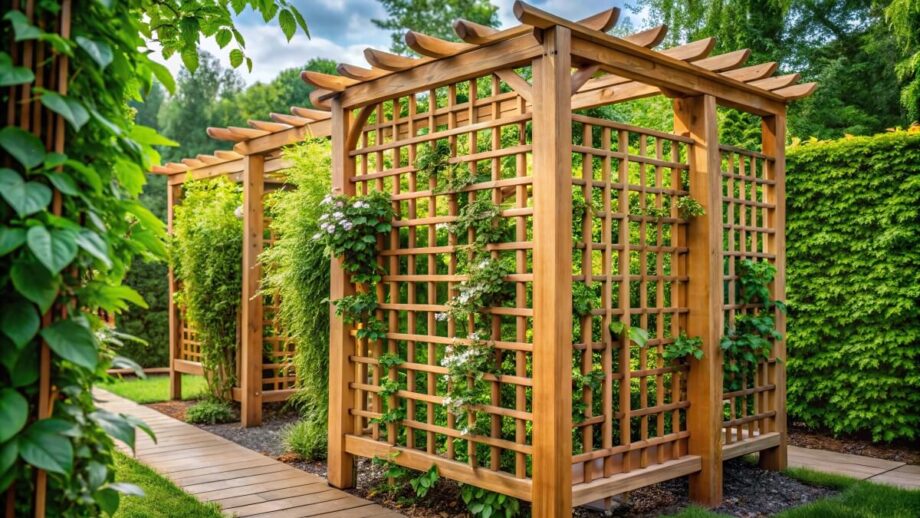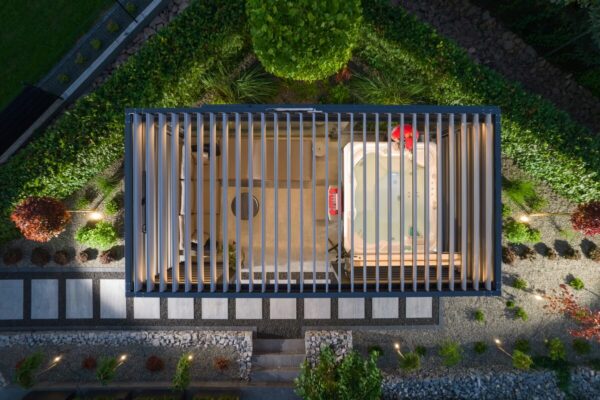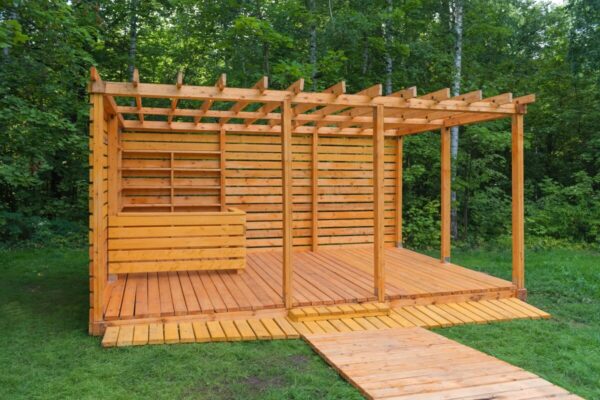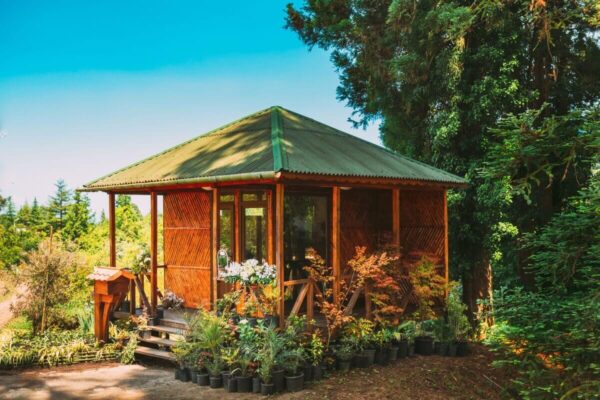Contents
- Understanding the benefits of wooden garden gazebos
- Design elements to consider in wooden garden gazebos
- Enhancing relaxation with well-placed wooden garden gazebos
- Creating functional spaces with wooden garden gazebos
- Maintenance tips for preserving wooden garden gazebos
- Most popular questions and answers
Understanding the benefits of wooden garden gazebos
Wooden garden gazebos offer a myriad of benefits that transform any outdoor space into a tranquil haven. Constructed from durable and aesthetically pleasing materials, these structures provide a compelling addition to any landscape. One of the primary advantages of wooden garden gazebos is their ability to blend seamlessly with natural surroundings, offering an organic aesthetic that enhances the beauty of your garden. Unlike metal or synthetic counterparts, wood has a timeless quality, creating a rustic charm that appeals to nature lovers. Furthermore, the natural tones and textures of wood provide a versatile design element that complements a variety of garden styles, from modern minimalist to classic English country.
The presence of a wooden garden gazebo in your backyard doesn’t just elevate the visual appeal; it also offers functional benefits. These structures provide a comfortable and shaded area where you can relax and unwind, sheltered from the harsh rays of the sun or an unexpected rain shower. This aspect turns your garden into a usable space regardless of the weather, making it perfect for outdoor dining, meditation, or simply enjoying a good book. Moreover, having a gazebo can effectively define an outdoor living space, creating a designated area for gatherings, celebrations, or peaceful solitude. This addition not only enhances lifestyle but also potentially increases property value, making it a wise investment for any homeowner.
Design elements to consider in wooden garden gazebos
When planning or purchasing a wooden garden gazebo, several key design elements must be considered to ensure it meets both functional and aesthetic needs. First, think about the size and shape of the gazebo, which should be proportional to your garden space. An overly large gazebo might dominate the landscape, while a small one might look out of place. Additionally, consider the roof style—whether you prefer a classic pitched roof, a more modern flat top, or an intricate pagoda design. Each offers varying degrees of elegance and utility, affecting both the appearance and the amount of shade or protection provided.
Material choice is paramount, especially when dealing with wooden structures. Opt for high-quality, pressure-treated wood to prevent decay and ensure longevity, particularly in humid or moist environments. Cedar and redwood are popular choices, known for their resistance to insects and rot. Also, consider additional features that can enhance the gazebo’s functionality, such as built-in seating, lattice walls for climbing plants, or even electrical outlets if you plan to spend extended time outdoors. By carefully selecting these design components, you can create a bespoke space that perfectly fits your vision of an outdoor oasis.
Enhancing relaxation with well-placed wooden garden gazebos
To truly transform your backyard into a sanctuary of peace, the placement and setting of wooden garden gazebos are crucial. Position the gazebo in a part of your garden that offers both privacy and a pleasant view. This might be near a blooming flowerbed, overlooking a water feature, or under the dappled shade of mature trees. The setting should inspire tranquility, encouraging relaxation and providing a refuge from the hustle and bustle of everyday life.
To enhance the calming atmosphere further, consider incorporating elements such as ambient lighting. Soft, warm lights can be installed in the gazebo to create a cozy ambiance during evening hours, perfect for unwinding after a long day. Additionally, you might introduce fragrant plants nearby, like lavender or jasmine, which can elevate the sensory experience, providing a subtle and soothing aroma. Auditory elements, such as wind chimes or a nearby water fountain, can also contribute to a deeper sense of relaxation, making your gazebo not just a visual centerpiece but a complete sensory retreat.
Creating functional spaces with wooden garden gazebos
Wooden garden gazebos are not just for relaxation; they can also be designed to serve multiple functions within your garden. A well-designed gazebo can act as an outdoor dining area, a yoga retreat, or even a creative workspace. For families, it can be a shelter for children’s play, safely nestled within the garden. By adding furniture such as a sturdy table and comfortable chairs, your gazebo can easily transform into a dining pavilion where you can entertain guests or enjoy meals al fresco.
For those who work from home or need a peaceful place for creative pursuits, a gazebo can serve as an inspiring outdoors office or studio. Equip it with necessary amenities, such as a portable power supply for electronic devices, and promote concentration and creativity in this unique setting. Additionally, consider integrating a small bookshelf or storage area to keep reading or crafting materials close at hand. With thoughtful design and purpose, a wooden garden gazebo can be more than just a beautiful feature; it becomes a versatile extension of your living space, catering to a variety of daily needs and activities.
Maintenance tips for preserving wooden garden gazebos
To ensure the longevity and beauty of wooden garden gazebos, regular maintenance is key. Wood, being a natural material, requires protection from elements such as sun, rain, and temperature fluctuations. Applying a high-quality sealant or wood stain can help preserve the gazebo’s color and prevent the wood from drying out or rotting. Regular inspections should be conducted to check for signs of wear, such as splintering or fungal growth, especially after rainy seasons.
In addition to periodic sealing, cleaning is crucial. Use a mild soap and water solution to scrub away any dirt or grime, and rinse thoroughly to prevent any residues from damaging the wood. Keep the area surrounding the gazebo clear of debris and ensure proper air circulation to minimize moisture buildup. Pruning plants and trees nearby will also help restrict exposure to damp conditions.
By following these maintenance routines, you can keep your wooden garden gazebo in excellent condition, ensuring it remains a beautiful and functional part of your outdoor oasis for many years. For more insight into how a gazebo could benefit your outdoor space, read here.
Most popular questions and answers
What is the best way to prepare the ground for a gazebo?
The best way to prepare the ground for a gazebo is to level and compact the soil thoroughly, ensuring a stable foundation. It’s crucial to remove any grass, debris, or rocks from the area to prevent uneven settling. Depending on your local climate and soil type, installing a concrete base or footings may be necessary for added stability.
How to maintain a wooden garden gazebo?
To maintain a wooden garden gazebo, regular cleaning and sealing with a weatherproof product are essential to protect it from the elements. Inspect the structure periodically for signs of damage like rot or paint peeling, and make repairs promptly. Trim any nearby plants to allow air circulation and prevent moisture buildup.
Can gazebos increase property value?
Gazebos can indeed increase property value by enhancing the aesthetic and functional appeal of the outdoor space. They provide a versatile area for relaxation or entertainment, adding to the livability of a home. A well-maintained gazebo adds an element of luxury and can attract potential buyers who value outdoor living enhancements.
Are wooden garden gazebos eco-friendly?
Wooden garden gazebos can be eco-friendly if made from sustainably sourced wood and maintained properly to prolong their lifespan. Using eco-friendly stains or sealants contributes to reducing environmental impact. Furthermore, wood as a renewable resource offers a natural aesthetic that integrates well with eco-conscious landscaping.
What design features should I consider for a gazebo?
When designing a gazebo, consider features like roof style, materials, and additional furnishings or utilities to enhance its functionality. Think about how the structure will integrate with your garden’s existing landscape and aesthetics. Features like lattice walls or built-in seating can add charm and practicality to the gazebo.




